Artigo
| Ligandless cloud point extraction of trace amounts of palladium and rhodium in road dust samples using Span 80 prior to their determination by flame atomic absorption spectrometry |
|
Mahmoud RoushaniI,*; Yar Mohammad BaghelaniI; Shahryar AbbasiI; Sayed Zia MohammadiII
IDepartment of Chemistry, Faculty of Sciences, Ilam University, Ilam, Iran Recebido em 21/01/2014 *e-mail: mahmoudroushani@yahoo.com In this study, a procedure is developed for cloud point extraction of Pd(II) and Rh(III) ions in aqueous solution using Span 80 (non-ionic surfactant) prior to their determination by flame atomic absorption spectroscopy. This method is based on the extraction of Pd(II) and Rh(III) ions at a pH of 10 using Span 80 with no chelating agent. We investigated the effect of various parameters on the recovery of the analyte ions, including pH, equilibration temperature and time, concentration of Span 80, and ionic strength. Under the best experimental conditions, the limits of detection based on 3Sb for Pd(II) and Rh(III) ions were 1.3 and 1.2 ng mL−1, respectively. Seven replicate determinations of a mixture of 0.5 µg mL−1 palladium and rhodium ions gave a mean absorbance of 0.058 and 0.053 with relative standard deviations of 1.8 and 1.6%, respectively. The developed method was successfully applied to the extraction and determination of the palladium and rhodium ions in road dust and standard samples and satisfactory results were obtained. INTRODUCTION Potential sources of heavy metal ion pollution include various industrial effluents, domestic activities, and erosion of natural deposits.1 However, if metal ions are continuously released into the biosphere, they can become one of the major sources of pollution. Some palladium compounds have been reported to pose potential threats to human health, causing asthma, allergies, rhinoconjunctivitis, and other serious health problems.2,3 Therefore, the determination of palladium and rhodium ions in environmental samples is one of the most important fields of study in analytical chemistry.4,5 Atomic absorption spectrometry (AAS) is currently the most common technique used in the determination of metals in different samples.6 When the concentration of an analyte is high, AAS determinations are usually made by flame atomic absorption spectrometry (FAAS), whereas when the concentration is low, AAS determinations are usually made by graphite furnace atomic absorption spectrometry (GFAAS). However, the direct determination of metal ions at trace levels by AAS alone is difficult not only due to this method's insufficient sensitivity, but also due to matrix interference. Therefore, due to their typically low concentrations, especially in environmental samples, there is a critical need for preconcentration of trace elements before AAS analysis. Additionally, since high levels of nontoxic components usually accompany analytes, a cleanup step is often required. In order to overcome these challenges, analytical chemists generally use separation-preconcentration techniques, including liquid-liquid extraction, coprecipitation, cloud point extraction, electrodeposition, and solid phase extraction.7-16 Cloud point extraction (CPE) is an interesting alternative because of its high extraction efficiency and enrichment factor. Compared with conventional liquid-liquid extraction, CPE uses water, thereby avoiding the use of large amounts of expensive, toxic, and flammable organic solvents.17 This makes it possible for CPE to achieve a much higher analyte concentration than does liquid-liquid extraction, because the micellar phase volume is about 10-100-fold less than the volume of the aqueous phase.18 CPE is based on the fact that the aqueous solution of nonionic and zwitterionic surfactants becomes cloudy when the experimental temperature is appropriately altered.19 The critical temperature, called the "cloud point", depends on the amphiphilic nature and concentration of the surfactant.20 When the temperature rises above the cloud point, the solution separates into two distinct phases: a surfactant-rich phase and an aqueous phase. This phenomenon is reportedly due to an increase in micellar size and the dehydration of the hydrated outer micellar layers with increases in temperature.21 In the present work, we developed a simple, rapid, and selective method for ligandless cloud point extraction (LL-CPE), using no chelating agent, for the determination of palladium and rhodium in road dust samples by flame atomic absorption spectrometry.
EXPERIMENTAL Instrumentation A SensAA GBC atomic absorption spectrometer (Dandenong, Australia) equipped with deuterium background correction, and an air-acetylene burner was used for absorbance measurements. Palladium and rhodium hollow cathode lamps were used as light sources at wavelengths of 244.8 and 343.5 nm, respectively. The operating parameters of the elements were set according to the manufacturer recommendations. The acetylene flow rate and the burner height were adjusted in order to obtain the maximum absorbance signal while aspirating the analyte solution. A Metrohm 692 pH meter (Herisau, Switzerland) was used for pH measurements. A Centurion scientific centrifuge model 1020 D.E. (West Sussex, United Kingdom) was used to accelerate phase separation. Reagents and solutions All chemicals were of analytical-reagent grade and were used without previous purification. Laboratory glassware was kept overnight in a 1.4 mol L−1 HNO3 solution. Before use, the glassware was washed with deionized water and dried. Stock solutions of palladium and rhodium ions at a concentration of 1000.0 µg mL−1 were purchased from Merck (Germany). Working reference solutions were obtained daily by stepwise dilution from stock solutions. A solution of 4.0% (v/v) Span 80 (Sigma, St Louis, USA) in deionized water was used as the surfactant agent. A buffer solution with pH = 10 was prepared from 0.2 mol L−1 disodium hydrogen phosphate and potassium dihydrogen phosphate. A certified reference material, road dust (BCR-723) with a maximum particle size of 90 µm, was purchased from the Institute of Reference Materials and Measurements (EU Joint Research Center, Geely, Belgium). Solutions of alkali metal salts (1%) and various metal salts (0.1%) were used for studying the interference of anions and cations, respectively. Procedure for LL-CPE For the LL-CPE, aliquots of a water sample containing 10.0 µg of Pd(II) and Rh(III) were pipetted into centrifuge tubes. Then, 1 mL of 0.2 mol L−1 phosphate buffer (pH 10.0), 1.0 mL of 4.0% Span 80, and 1 mL NaCl 10.0% (w/v) were sequentially added to the tubes until reaching a final volume of 8 mL. The samples were then shaken and left to stand in a thermostatic water bath for 10 min at 45 ºC before centrifugation. Separation of the two phases was achieved by centrifugation for 5 min at 4000 rpm. The mixtures were cooled in an ice bath in order to increase the viscosity of the surfactant-rich phase, and the aqueous phase was easily decanted by simply inverting the tube. Then, to dilute the surfactant-rich phase, a 1.5 mL solution of 0.5 mol L−1 of HNO3 in ethanol was added. The final solutions were aspirated directly into the AAS flame against a blank prepared in the same manner without the addition of metal ions. Sample preparation Road dust samples were collected from three different densely trafficked roadsides in Kerman, Iran. The samples were dried at 100 ºC for 2 h, then ground, passed through a 200-mesh sieve, and homogenized. Approximately 5.0 g of each sample was put into a beaker. To decompose the dust samples, 20 mL of aqua regia was added to the beaker, and the mixture was heated almost to dryness. Then, 15 mL more aqua regia was added to the residue and the mixture was again evaporated to dryness. After this, 20 mL of deionized water was added to each beaker, and the insoluble matter was filtered through a filter paper (blue band) and washed with deionized water. The pH of the samples was adjusted to 10.0 and deionized water was added until the total volumes were 50.0 mL in three calibrated flasks. The BCR-273 was also prepared in the same manner as the road dust samples.
RESULTS AND DISCUSSION In this study, a combination of LL-CPE with FAAS was developed for preconcentrating and determining trace amounts of Pd(II) and Rh(III) ions in road dust samples. First, a phosphate buffer and Span 80 solution were added to the sample solution. In this step, the palladium and rhodium ions reacted with the phosphate ions and analyte-phosphate complexes were formed. The solution then became cloudy. After the formation of the cloudy solution, the analyte-phosphate complexes diffused into the surfactant phase. Several parameters affecting the performance of the LL-CPE were investigated, including the Span 80 concentration, pH, ionic strength, interference ions, equilibration temperature, and extraction time. Effect of pH The pH of the sample solution is one of the important factors affecting the formation of nonionic compounds and their subsequent extraction. We studied the effects of pH, over the range 3-11, on the LL-CPE of the palladium and rhodium ions. In this stage, dilute HNO3 and NaOH solutions were used to adjust the pH. The results, shown in Figure 1, reveal that with increased pH, the extraction percent of the analytes increased dramatically and reached maximum at a pH of 10.0. At pHs higher than 10, metal ions can precipitate as hydroxides, and the extraction percent of the analyte ions decreased. Therefore, phosphate buffer solution (pH=10) was used for adjust of pH.
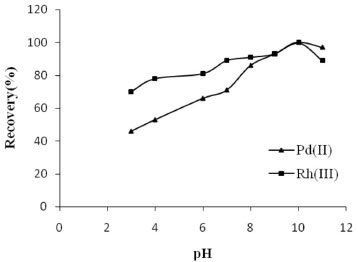 Figure 1. Effect of pH on the extraction of the analyte ions. Conditions: Pd (II) and Rh (III), 10.0 µg; buffer, 1 mL; NaCl 10% (w/v), 1 mL; Span80 (4%), 1 mL; Extraction time, 10 min; Extraction temperature, 45 ºC
The volume of the phosphate buffer (pH 10) was also studied. Results showed that the addition of 1-4 mL of buffer had no effect on the extraction of the analyte ions. Therefore, 1 mL of buffer was used in all subsequent experiments. Effect of Span 80 Since the amount of Span 80 also plays an important role in the subsequent extraction, we studied the effect of Span 80 concentrations, in a range from 1.0-5.0% (v/v), on the extraction efficiency. Results showed that the highest recoveries of the Pd(II) and Rh(III) ions were obtained with a 4.0% (v/v) Span 80 concentration. Volumes between 0.5-3.0 mL of Span 80 (4%, v/v) were also investigated. The results showed (Figure 2) that the highest recoveries for Pd(II) and Rh(III) ions were obtained in the volume range of 1-1.5 mL. Therefore, 1 mL of Span 80 (4%, v/v) was used in all subsequent experiments.
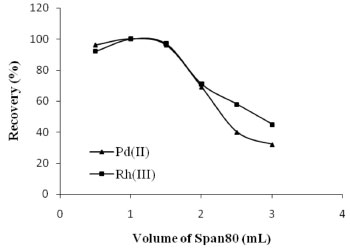 Figure 2. Effect of Span 80 volume on the extraction of the analyte ions. Conditions were the same as in Figure 1, with the exception of the Span 80 volume
Effect of equilibrium temperature Temperature is another of the main factors affecting the separation of the cloud point extraction phases. We selected a range of temperatures between 25 and 60 ºC to determine the temperature that would promote higher analytical signals for palladium and rhodium ions. As shown in Figure 3, the highest extraction percentages were obtained at 45 ºC. Therefore, 45 ºC was chosen as the optimum temperature for the experiments that followed.
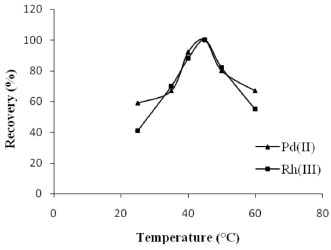 Figure 3. Effect of equilibrium temperature on the extraction of the analyte ions. Conditions were the same as in Figure 1, with the exception of the equilibrium temperature
Effect of equilibrium time With respect to the equilibration time, the shortest possible incubation time is desirable, since incubation compromises the completion of the reaction and the efficiency of the separation of phases. The extraction efficiency's dependence upon equilibration time was studied in the range of 5-25 min. The results showed that an equilibration time of 10 min was adequate to achieve quantitative extraction for both ions. Effect of ionic strength The ionic strength of the solution also has a strong effect on the cloud point temperature and efficiency of extraction. To investigate the influence of ionic strength on the extraction of the analyte ions, several experiments were performed using different volumes of NaCl 10% in the range of 0-1.5 mL. All other experimental conditions were kept constant. The results, presented in Figure 4, show that maximum extraction efficiency was obtained in 1 mL of NaCl. Therefore, 1 mL of NaCl 10% was used in all further experiments.
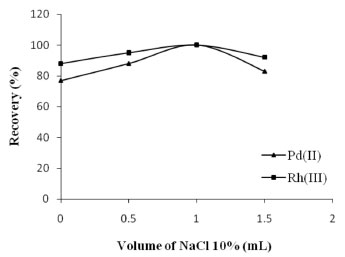 Figure 4. Effect of NaCl volume on the extraction of the analyte ions. Conditions were the same as in Figure 1, with the exception of the NaCl volume
Effect of foreign ions In view of the typically high selectivity provided by FAAS, eventual interference processes may be attributed to the preconcentration step. To gain a better understanding, various salts and metal ions were added individually to a solution containing 10.0 µg of Pd(II) and Rh(III) ions and the developed procedure was applied. The tolerance limit was set to be the concentration of the diverse ion required to cause ± 5% error. The tolerance limits of the interference ions are shown in Table 1. These results demonstrate that the presence of large amounts of species commonly present in water samples have no significant effect on the LL-CPE of palladium and rhodium ions.

Analytical figures of merit Under optimized conditions, calibration curves were constructed for the determination of palladium and rhodium ions according to the extraction procedure. The linearity of the Pd(II) and Rh(III) ions in the original solution (8 mL) was maintained in a range between 0.005-2.0 and 0.005-2.5 µg mL−1, respectively. The detection limits of the method, based on 3Sb (n=6) for the Pd(II) and Rh(III) ions, were 1.3 and 1.2 ng mL−1 in the original solution, respectively. Seven replicate determinations, in a mixture of 0.5 µg mL−1 palladium and rhodium ions in the original solution, gave a mean absorbance of 0.058 and 0.053 with relative standard deviations of 1.8% and 1.6%, respectively. The ratio of the initial sample volume (8 mL) to the final volume is the preconcentration factor. With respect to the final volume (1.5 mL) the preconcentration factor for the palladium and rhodium ions was 5.3. The enrichment factors were calculated as the ratio of the analytical signal obtained after and before extraction. The enrichment factors for the palladium and rhodium ions were 5.2 and 5.1, respectively. The analytical characteristics of the extraction procedure are provided in Table 2.
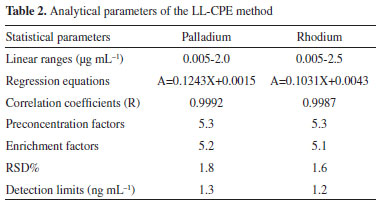
Analysis of certified reference material The accuracy and applicability of the extraction procedure has been validated by the determination of palladium and rhodium ions in one road dust standard sample (BCR-723). The certified values of palladium and rhodium are 6.0 and 12.8 µg kg−1, respectively. An aliquot of this certified reference material was also subjected to the LL-CPE procedure for preconcentrating and determining palladium and rhodium ions using the standard addition method. The concentrations of palladium and rhodium in BCR-723 were found to be 5.8 ± 0.4 and 13.2 ± 0.5 µg kg−1, respectively. A statistical comparison by t-test (p < 0.05) showed no significant difference between the certified values and the experimental results. Application of the method The results of this extraction procedure, applied to the determination of palladium and rhodium ions in road dust samples, are provided in Table 3. We also studied the recovery of palladium and rhodium ions from road dust samples spiked with known amounts of palladium and rhodium ions. These results, also shown in Table 3, show that the additional Pd(II) and Rh(III) ions can be quantitatively recovered from the road dust samples by the extraction procedure. These results demonstrate the applicability of the extraction procedure for palladium and rhodium determination in road dust samples.
CONCLUSIONS The LL-CPE method presented here, using a nonionic surfactant such as Span 80, is shown to be an efficient, lower in toxicity, simple, rapid separation and preconcentration methodology for determining Pd(II) and Rh(III) ions in road dust samples with no chelating agent. The accuracy of this LL-CPE method was assessed though recovery experiments and certified reference materials analysis. Low limits of detection and good precision were obtained. The method was also verified by an analysis of road dust samples which yielded satisfactory results.
REFERENCES 1. Faraji, M.; Yamini, Y.; Saleh, A.; Rezaee, M.; Ghambarian, M.; Hassani, R.; Anal. Chim. Acta 2010, 659, 172. 2. Merget, R.; Rosner, G.; Sci. Total Environ. 2001, 270, 165. 3. Ravindra, K.; Bencs, L.; Grieken, R. V.; Sci. Total Environ. 2004, 318, 1. 4. Saavedra, R.; Soto, C.; Yanez, J.; Ines Toral, M.; J. Hazard. Mater. 2009, 167, 970. 5. Ahmadzadeh Kokya, T.; Farhadi, K.; J. Hazard. Mater. 2009, 169, 726. 6. Filik, H.; Apak, R.; J. Hazard. Mater. 2009, 169, 766. 7. Khuhawar, M. Y.; Das, P.; Dewani, V. K.; J. Chem. Soc. Pak. 2005, 27, 160. 8. Suvardhan, K.; Babu, S. H.; Kumar, K. S.; Krishnaiah, L.; Reddy, A. V. R.; Chiranjeevi, P.; Chem. Biodiversity 2005, 2, 477. 9. Nayak, D.; Banerjee, A.; Lahiri, S.; Appl. Radiat. Isot. 2007, 65, 891. 10. Karatepe, A. U.; Soylak, M.; Elci, L.; Anal. Lett. 2002, 35, 1561. 11. Soylak, M.; Karatepe, A. U.; Elci, L.; Dogan, M.; Turk. J. Chem. 2003, 27, 235. 12. Luconi, M. O.; Olsina, R. A.; Fernandez, L. P.; Silva, M. F.; J. Hazard. Mater. 2006, 128, 240. 13. Singh, P.; Mittal, S.; Sharma, R. K.; Indian J. Chem. Technol. 2007, 14, 204. 14. Mohammadi, S. Z.; Afzali, D.; Taher, M. A.; Baghelani, Y. M.; Microchim. Acta 2010, 168, 123. 15. Mohammadi, S. Z.; Karimi, M. A.; Hamidian, H.; Baghelani, Y. M.; Karimzadeh, L.; J. Chil. Chem. Soc. 2011, 56, 682. 16. Mohammadi, S. Z.; Karimi, M. A.; Hamidian, H.; Baghelani, Y. M.; Karimzadeh, L.; Sci. Iran. 2011, 18, 1636. 17. Wu, D.; Wu, Q.; Bian, R.; Wang, Y.; Sep. Sci. Technol. 2007, 42, 2693. 18. Ghaedi, M.; Shokrollahi, A.; Niknam, K.; Niknam, E.; J. Hazard. Mater. 2009, 168, 1022. 19. Han F.; Yin, R.; Shi, X.; Jia, Q.; Liu, H.; Yao, H.; Xu, L.; Li, S.; J. Chromatogr. B 2008, 868, 64. 20. Madej, K.; Trends Anal. Chem. 2009, 28, 436. 21. Purkait, M. K.; Das Gupta, S.; De, S.; J. Hazard. Mater. 2006, 137, 827. |
On-line version ISSN 1678-7064 Printed version ISSN 0100-4042
Qu�mica Nova
Publica��es da Sociedade Brasileira de Qu�mica
Caixa Postal: 26037
05513-970 S�o Paulo - SP
Tel/Fax: +55.11.3032.2299/+55.11.3814.3602
Free access






